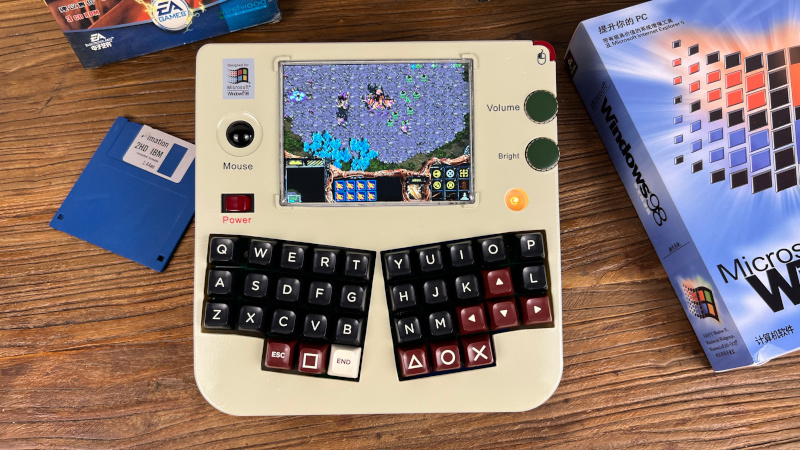Handheld computers have become very much part of the hardware hacker scene, as the advent of single board computers long on processor power but short on power consumption has given us the tools we need to build them ourselves. Handheld retrocomputers face something of an uphill struggle though, as many of the components are over-sized, and use a lot of power. [Changliang Li] has taken on the task though, putting an industrial Pentium PC in a rather well-designed SLA printed case.
Aside from the motherboard there’s a VGA screen, a CompactFlash card attached to the IDE interface, and a Logitech trackball. As far as we can see the power comes from a USB-C PD board, and there’s a split mechanical keyboard on the top side. It runs Windows 98, and a selection of peak ’90s games are brought out to demonstrate.
We like this project for its beautiful case and effective use of parts, but we’re curious whether instead of the Pentium board it might have been worth finding a later industrial PC to give it a greater breadth of possibilities, there being few x86 SBCs. Either way it would have blown our minds back in ’98, and we can see it’s a ton of fun today. Take a look at the machine in the video below the break.
Thanks [Stephen Walters] for the tip.
















If this handheld PC has at least one USB port for attaching a full sized keyboard and mouse, or even a PS/2 port, I’d be all over it.
A VGA port would be nice too.
I’ve been wanting a retro gaming system on real hardware for some time now.
Interesting place for a toggle power button, between the keyboard and the mouse.
Because he’s using the pc/104 form factor, these options are easily available as long as you pick the right main board. In the project parts list he even says to use whatever PC/104 board you can find cheaply.
You can find PC/104 boards that go as modern as usb3 and pci express.
Hi! USB was fairly new when Windows 98 came out.
It had been nicknamed “useless serial bus” at one point.
While it’s technically true that USB ports did exist since about 1996 or so, they weren’t really a thing in the 90s.
Also, the first USB ports were USB 1.0 rather than USB 1.1 or USB 2.0 and had some stability issues.
Some 90s mainboards didn’t even bother to have rear ports, but just USB headers.
Different USB 1.x host controller interfaces did exist, too (UHCI vs OHCI).
In the late 90s, USB ports were mainly used for such things as mice, keyboards, 56k modems and cheap webcams.
The majority of users did still used serial ports, SCSI ports, MIDI/Game ports or parallel ports to attach worthy things (such as flatbed scanners).
Game controllers and printers and scanners primarily used the traditional ports, still.
That had the advantage that DOS support was still available, DOS was still important at the time.
Modern SVGA DOS games were released up until 1997, at very least.
Also, in terms of printers, dedicated print servers had supported centronics ports but not USB.
By turn of the century, USB adoption increased.
By the time Windows XP was out the use of USB devices was very common among users.
But peripherals with traditional ports continued to stick around for a little longer.
I suspect that this was dismissed as too conservative; but (especially in light of the project’s failure everywhere except as a basis for newer Intel MEs) things like this always make me wonder how Intel’s “Quark” product would have gone if they hadn’t gone aggressively legacy free in ways that required their own oddball Linux build; but instead just kicked out the best Pentium Pro-alike 18 years of process improvements could offer; with all the IBM PC Compatible stuff that software expects.
Probably wouldn’t have been a truly enormous market; a lot of the conservative industrial/embedded stuff isn’t super power constrained; but compared to the basically nonexistent “would you like the board support and legacy compatibility of a dodgy ARM SoC along with the cost of Intel x86?” market; a ‘Pentium; but either hits the power consumption of bigger microcontrollers or clocks like you would have only dreamed of in ’95’ would at least have been a fun product.
That ortholinear keyboard has me swooning.
I’ve been able to hold pentiums in my hand since the 90’s.
Today I learned about PC/104, the x86 single-board computer form factor from the 80s.
https://en.wikipedia.org/wiki/PC/104
It’s interesting that the power supply and accessories snap together like a sandwich (“hat” style) rather than perpendicular to the mobo like in a desktop.
The board he’s using is in the ~200mhz range. But I see options over 1ghz. One manufacturer I see still around is Toronto Microelectronics.